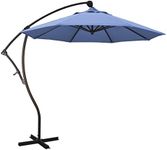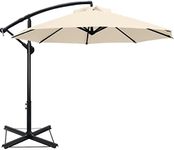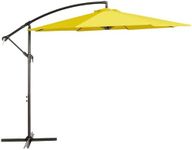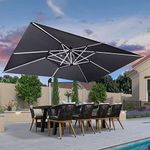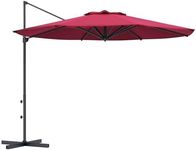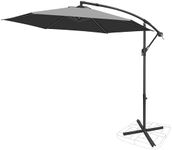Buying Guide for the Best Cantilever Umbrellas
Choosing the right cantilever umbrella can make your outdoor space much more comfortable and enjoyable. These umbrellas are popular because they provide shade without a central pole, giving you more flexibility in arranging your furniture and maximizing usable space. When shopping for a cantilever umbrella, it's important to consider several key features to ensure you get one that fits your needs, is easy to use, and will last for years.Canopy SizeThe canopy size refers to the diameter or width of the umbrella's shade area. This is important because it determines how much space the umbrella can cover and protect from the sun. Canopy sizes typically range from about 8 feet to over 13 feet. Smaller canopies (8-10 feet) are suitable for compact patios or small dining sets, while medium sizes (10-12 feet) work well for larger tables or lounge areas. Extra-large canopies (12 feet and above) are best for big gatherings or wide open spaces. To pick the right size, consider the area you want to shade and the number of people or furniture pieces you want to cover.
Frame MaterialThe frame material is what the umbrella's structure is made from, and it affects both durability and appearance. Common materials include aluminum, steel, and wood. Aluminum frames are lightweight, rust-resistant, and easy to move, making them a good choice for most users. Steel frames are strong but can be heavier and may require more maintenance to prevent rust. Wooden frames offer a classic look but need regular care to withstand the elements. Choose a frame material based on your climate, how much maintenance you're willing to do, and your style preferences.
Canopy FabricThe canopy fabric is the material that provides the shade, and its quality affects how well it blocks the sun, resists fading, and stands up to weather. Popular fabrics include polyester, olefin, and acrylic. Polyester is affordable and comes in many colors, but may fade faster. Olefin is more durable and resists mildew, while acrylic (like Sunbrella) offers the best fade resistance and weather protection. If you want your umbrella to last and keep its color, look for high-quality, UV-resistant fabrics. Think about how much sun exposure your umbrella will get and how often you'll use it.
Tilt and Rotation MechanismThe tilt and rotation mechanism allows you to adjust the angle and direction of the canopy to block the sun as it moves throughout the day. Some umbrellas offer simple tilt features, while others can rotate 360 degrees or have multiple tilt positions. This is important for maximizing shade without having to move the entire umbrella. If your outdoor area gets sun from different directions or you want to use the umbrella at various times of day, look for models with easy-to-use tilt and rotation options.
Base and StabilityThe base is what keeps the umbrella upright and stable, especially in windy conditions. Cantilever umbrellas often require heavier or specially designed bases because of their offset design. Some come with a base included, while others require you to purchase one separately. The weight and type of base you need depends on the size of the umbrella and the typical weather in your area. For safety and peace of mind, always ensure your base is heavy enough to prevent tipping, especially if you live in a windy location.
Ease of OperationEase of operation refers to how simple it is to open, close, and adjust the umbrella. Features like crank lifts, push-button tilts, and smooth-gliding mechanisms make using the umbrella more convenient. If you plan to adjust your umbrella frequently or want something that's easy for everyone to use, look for user-friendly controls and mechanisms. Consider your own strength and mobility, as well as who else might be using the umbrella.


